Competitive Strategies: Analysis of SWOT, PESTLE, and Porter's Model
VerifiedAdded on 2020/03/28
|5
|1774
|57
Essay
AI Summary
This essay provides a comprehensive analysis of competitive strategies used by businesses to thrive in the global market. It delves into three key analytical tools: SWOT, PESTLE, and Porter's Five Forces. The essay explains how these tools are used to evaluate internal strengths and weaknesses, external opportunities and threats, and the impact of political, economic, social, technological, environmental, and legal factors on organizational structure. It further explores the dynamics of buyer power, supplier power, threat of substitutes, threat of new entry, and competitive rivalry. Through examples like PepsiCo and Walmart, the essay demonstrates how these frameworks are applied in strategic planning, investment decisions, and profit analysis, emphasizing their importance in achieving a competitive edge. The essay concludes by underscoring the indispensability of these tools for both small and large-scale companies in fostering growth and making informed decisions.
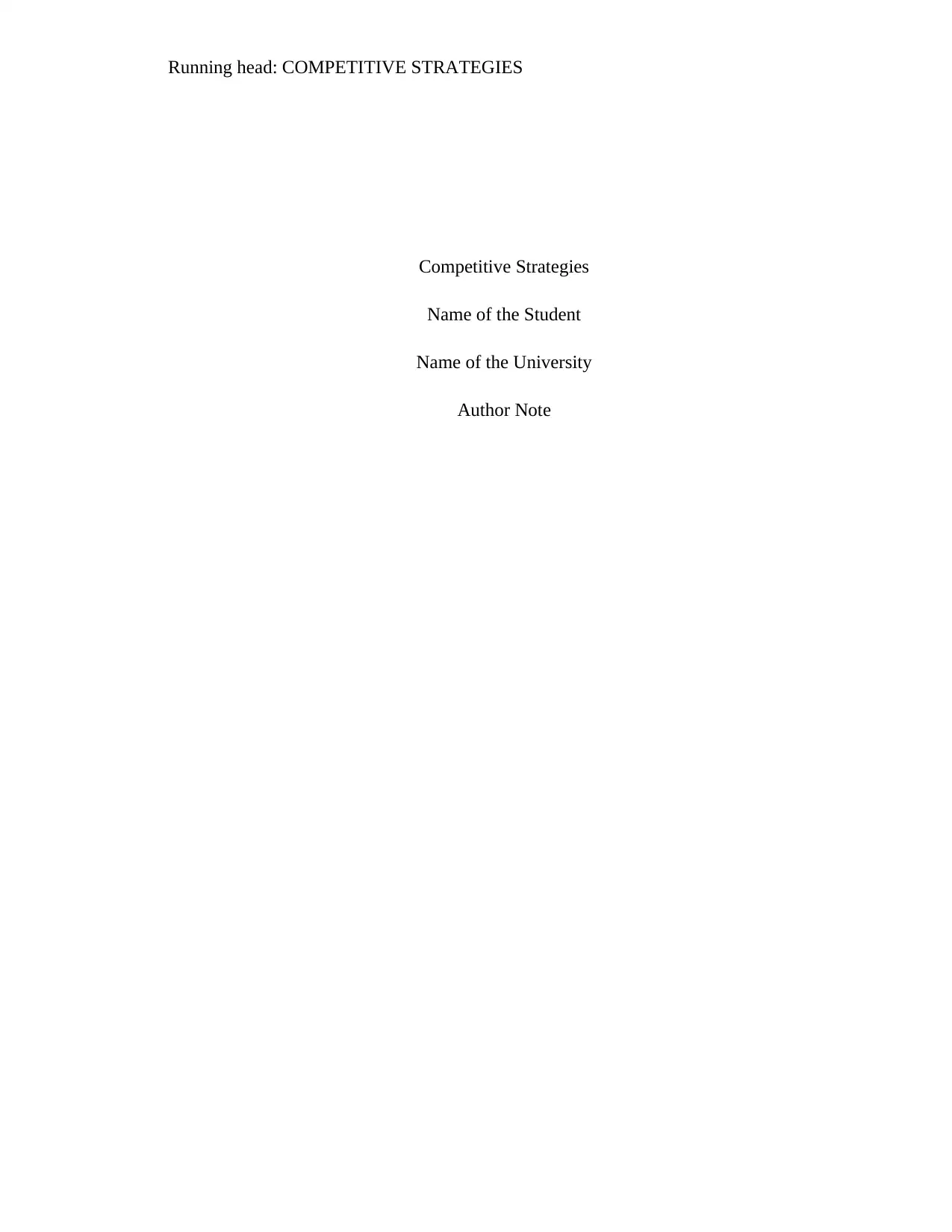
Running head: COMPETITIVE STRATEGIES
Competitive Strategies
Name of the Student
Name of the University
Author Note
Competitive Strategies
Name of the Student
Name of the University
Author Note
Paraphrase This Document
Need a fresh take? Get an instant paraphrase of this document with our AI Paraphraser
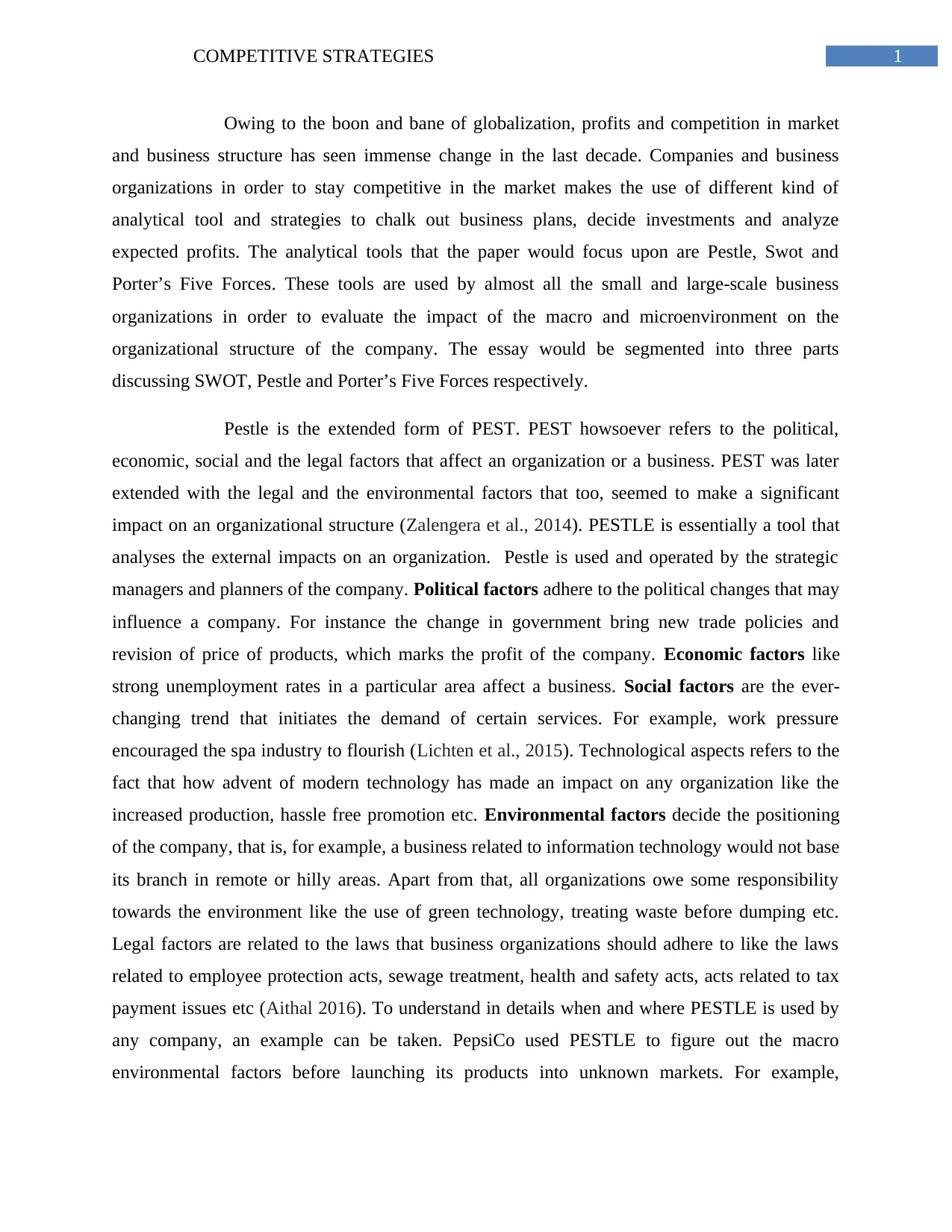
1COMPETITIVE STRATEGIES
Owing to the boon and bane of globalization, profits and competition in market
and business structure has seen immense change in the last decade. Companies and business
organizations in order to stay competitive in the market makes the use of different kind of
analytical tool and strategies to chalk out business plans, decide investments and analyze
expected profits. The analytical tools that the paper would focus upon are Pestle, Swot and
Porter’s Five Forces. These tools are used by almost all the small and large-scale business
organizations in order to evaluate the impact of the macro and microenvironment on the
organizational structure of the company. The essay would be segmented into three parts
discussing SWOT, Pestle and Porter’s Five Forces respectively.
Pestle is the extended form of PEST. PEST howsoever refers to the political,
economic, social and the legal factors that affect an organization or a business. PEST was later
extended with the legal and the environmental factors that too, seemed to make a significant
impact on an organizational structure (Zalengera et al., 2014). PESTLE is essentially a tool that
analyses the external impacts on an organization. Pestle is used and operated by the strategic
managers and planners of the company. Political factors adhere to the political changes that may
influence a company. For instance the change in government bring new trade policies and
revision of price of products, which marks the profit of the company. Economic factors like
strong unemployment rates in a particular area affect a business. Social factors are the ever-
changing trend that initiates the demand of certain services. For example, work pressure
encouraged the spa industry to flourish (Lichten et al., 2015). Technological aspects refers to the
fact that how advent of modern technology has made an impact on any organization like the
increased production, hassle free promotion etc. Environmental factors decide the positioning
of the company, that is, for example, a business related to information technology would not base
its branch in remote or hilly areas. Apart from that, all organizations owe some responsibility
towards the environment like the use of green technology, treating waste before dumping etc.
Legal factors are related to the laws that business organizations should adhere to like the laws
related to employee protection acts, sewage treatment, health and safety acts, acts related to tax
payment issues etc (Aithal 2016). To understand in details when and where PESTLE is used by
any company, an example can be taken. PepsiCo used PESTLE to figure out the macro
environmental factors before launching its products into unknown markets. For example,
Owing to the boon and bane of globalization, profits and competition in market
and business structure has seen immense change in the last decade. Companies and business
organizations in order to stay competitive in the market makes the use of different kind of
analytical tool and strategies to chalk out business plans, decide investments and analyze
expected profits. The analytical tools that the paper would focus upon are Pestle, Swot and
Porter’s Five Forces. These tools are used by almost all the small and large-scale business
organizations in order to evaluate the impact of the macro and microenvironment on the
organizational structure of the company. The essay would be segmented into three parts
discussing SWOT, Pestle and Porter’s Five Forces respectively.
Pestle is the extended form of PEST. PEST howsoever refers to the political,
economic, social and the legal factors that affect an organization or a business. PEST was later
extended with the legal and the environmental factors that too, seemed to make a significant
impact on an organizational structure (Zalengera et al., 2014). PESTLE is essentially a tool that
analyses the external impacts on an organization. Pestle is used and operated by the strategic
managers and planners of the company. Political factors adhere to the political changes that may
influence a company. For instance the change in government bring new trade policies and
revision of price of products, which marks the profit of the company. Economic factors like
strong unemployment rates in a particular area affect a business. Social factors are the ever-
changing trend that initiates the demand of certain services. For example, work pressure
encouraged the spa industry to flourish (Lichten et al., 2015). Technological aspects refers to the
fact that how advent of modern technology has made an impact on any organization like the
increased production, hassle free promotion etc. Environmental factors decide the positioning
of the company, that is, for example, a business related to information technology would not base
its branch in remote or hilly areas. Apart from that, all organizations owe some responsibility
towards the environment like the use of green technology, treating waste before dumping etc.
Legal factors are related to the laws that business organizations should adhere to like the laws
related to employee protection acts, sewage treatment, health and safety acts, acts related to tax
payment issues etc (Aithal 2016). To understand in details when and where PESTLE is used by
any company, an example can be taken. PepsiCo used PESTLE to figure out the macro
environmental factors before launching its products into unknown markets. For example,
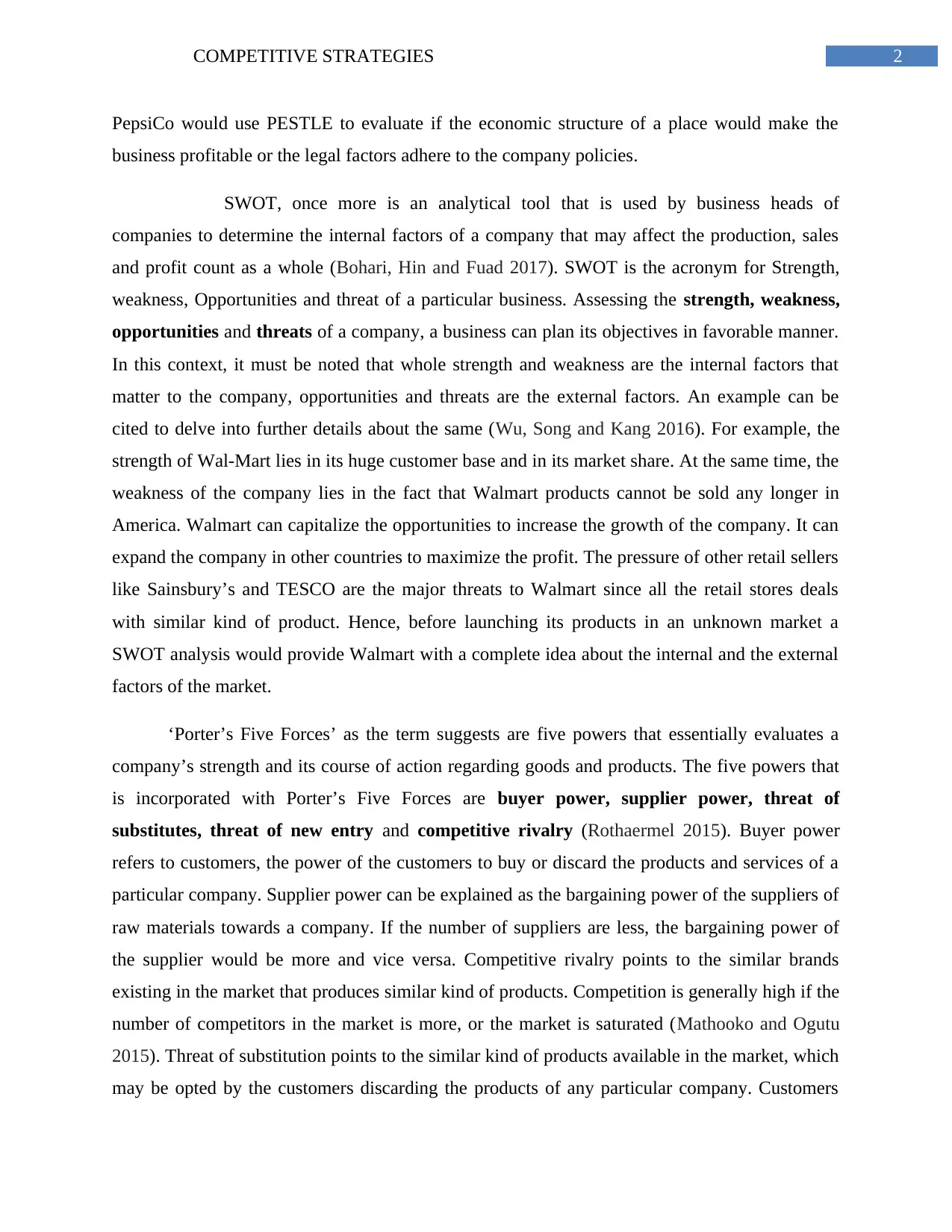
2COMPETITIVE STRATEGIES
PepsiCo would use PESTLE to evaluate if the economic structure of a place would make the
business profitable or the legal factors adhere to the company policies.
SWOT, once more is an analytical tool that is used by business heads of
companies to determine the internal factors of a company that may affect the production, sales
and profit count as a whole (Bohari, Hin and Fuad 2017). SWOT is the acronym for Strength,
weakness, Opportunities and threat of a particular business. Assessing the strength, weakness,
opportunities and threats of a company, a business can plan its objectives in favorable manner.
In this context, it must be noted that whole strength and weakness are the internal factors that
matter to the company, opportunities and threats are the external factors. An example can be
cited to delve into further details about the same (Wu, Song and Kang 2016). For example, the
strength of Wal-Mart lies in its huge customer base and in its market share. At the same time, the
weakness of the company lies in the fact that Walmart products cannot be sold any longer in
America. Walmart can capitalize the opportunities to increase the growth of the company. It can
expand the company in other countries to maximize the profit. The pressure of other retail sellers
like Sainsbury’s and TESCO are the major threats to Walmart since all the retail stores deals
with similar kind of product. Hence, before launching its products in an unknown market a
SWOT analysis would provide Walmart with a complete idea about the internal and the external
factors of the market.
‘Porter’s Five Forces’ as the term suggests are five powers that essentially evaluates a
company’s strength and its course of action regarding goods and products. The five powers that
is incorporated with Porter’s Five Forces are buyer power, supplier power, threat of
substitutes, threat of new entry and competitive rivalry (Rothaermel 2015). Buyer power
refers to customers, the power of the customers to buy or discard the products and services of a
particular company. Supplier power can be explained as the bargaining power of the suppliers of
raw materials towards a company. If the number of suppliers are less, the bargaining power of
the supplier would be more and vice versa. Competitive rivalry points to the similar brands
existing in the market that produces similar kind of products. Competition is generally high if the
number of competitors in the market is more, or the market is saturated (Mathooko and Ogutu
2015). Threat of substitution points to the similar kind of products available in the market, which
may be opted by the customers discarding the products of any particular company. Customers
PepsiCo would use PESTLE to evaluate if the economic structure of a place would make the
business profitable or the legal factors adhere to the company policies.
SWOT, once more is an analytical tool that is used by business heads of
companies to determine the internal factors of a company that may affect the production, sales
and profit count as a whole (Bohari, Hin and Fuad 2017). SWOT is the acronym for Strength,
weakness, Opportunities and threat of a particular business. Assessing the strength, weakness,
opportunities and threats of a company, a business can plan its objectives in favorable manner.
In this context, it must be noted that whole strength and weakness are the internal factors that
matter to the company, opportunities and threats are the external factors. An example can be
cited to delve into further details about the same (Wu, Song and Kang 2016). For example, the
strength of Wal-Mart lies in its huge customer base and in its market share. At the same time, the
weakness of the company lies in the fact that Walmart products cannot be sold any longer in
America. Walmart can capitalize the opportunities to increase the growth of the company. It can
expand the company in other countries to maximize the profit. The pressure of other retail sellers
like Sainsbury’s and TESCO are the major threats to Walmart since all the retail stores deals
with similar kind of product. Hence, before launching its products in an unknown market a
SWOT analysis would provide Walmart with a complete idea about the internal and the external
factors of the market.
‘Porter’s Five Forces’ as the term suggests are five powers that essentially evaluates a
company’s strength and its course of action regarding goods and products. The five powers that
is incorporated with Porter’s Five Forces are buyer power, supplier power, threat of
substitutes, threat of new entry and competitive rivalry (Rothaermel 2015). Buyer power
refers to customers, the power of the customers to buy or discard the products and services of a
particular company. Supplier power can be explained as the bargaining power of the suppliers of
raw materials towards a company. If the number of suppliers are less, the bargaining power of
the supplier would be more and vice versa. Competitive rivalry points to the similar brands
existing in the market that produces similar kind of products. Competition is generally high if the
number of competitors in the market is more, or the market is saturated (Mathooko and Ogutu
2015). Threat of substitution points to the similar kind of products available in the market, which
may be opted by the customers discarding the products of any particular company. Customers
⊘ This is a preview!⊘
Do you want full access?
Subscribe today to unlock all pages.

Trusted by 1+ million students worldwide
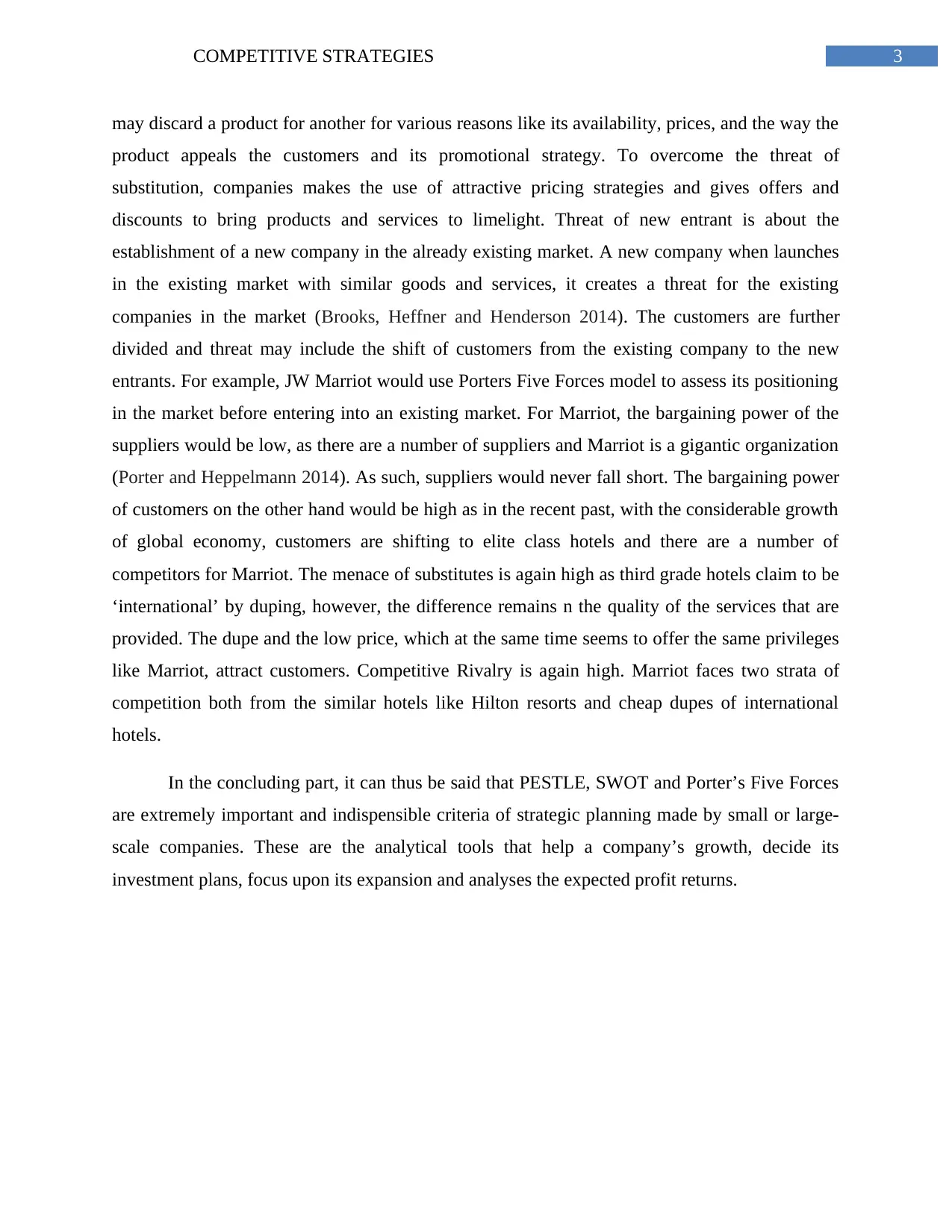
3COMPETITIVE STRATEGIES
may discard a product for another for various reasons like its availability, prices, and the way the
product appeals the customers and its promotional strategy. To overcome the threat of
substitution, companies makes the use of attractive pricing strategies and gives offers and
discounts to bring products and services to limelight. Threat of new entrant is about the
establishment of a new company in the already existing market. A new company when launches
in the existing market with similar goods and services, it creates a threat for the existing
companies in the market (Brooks, Heffner and Henderson 2014). The customers are further
divided and threat may include the shift of customers from the existing company to the new
entrants. For example, JW Marriot would use Porters Five Forces model to assess its positioning
in the market before entering into an existing market. For Marriot, the bargaining power of the
suppliers would be low, as there are a number of suppliers and Marriot is a gigantic organization
(Porter and Heppelmann 2014). As such, suppliers would never fall short. The bargaining power
of customers on the other hand would be high as in the recent past, with the considerable growth
of global economy, customers are shifting to elite class hotels and there are a number of
competitors for Marriot. The menace of substitutes is again high as third grade hotels claim to be
‘international’ by duping, however, the difference remains n the quality of the services that are
provided. The dupe and the low price, which at the same time seems to offer the same privileges
like Marriot, attract customers. Competitive Rivalry is again high. Marriot faces two strata of
competition both from the similar hotels like Hilton resorts and cheap dupes of international
hotels.
In the concluding part, it can thus be said that PESTLE, SWOT and Porter’s Five Forces
are extremely important and indispensible criteria of strategic planning made by small or large-
scale companies. These are the analytical tools that help a company’s growth, decide its
investment plans, focus upon its expansion and analyses the expected profit returns.
may discard a product for another for various reasons like its availability, prices, and the way the
product appeals the customers and its promotional strategy. To overcome the threat of
substitution, companies makes the use of attractive pricing strategies and gives offers and
discounts to bring products and services to limelight. Threat of new entrant is about the
establishment of a new company in the already existing market. A new company when launches
in the existing market with similar goods and services, it creates a threat for the existing
companies in the market (Brooks, Heffner and Henderson 2014). The customers are further
divided and threat may include the shift of customers from the existing company to the new
entrants. For example, JW Marriot would use Porters Five Forces model to assess its positioning
in the market before entering into an existing market. For Marriot, the bargaining power of the
suppliers would be low, as there are a number of suppliers and Marriot is a gigantic organization
(Porter and Heppelmann 2014). As such, suppliers would never fall short. The bargaining power
of customers on the other hand would be high as in the recent past, with the considerable growth
of global economy, customers are shifting to elite class hotels and there are a number of
competitors for Marriot. The menace of substitutes is again high as third grade hotels claim to be
‘international’ by duping, however, the difference remains n the quality of the services that are
provided. The dupe and the low price, which at the same time seems to offer the same privileges
like Marriot, attract customers. Competitive Rivalry is again high. Marriot faces two strata of
competition both from the similar hotels like Hilton resorts and cheap dupes of international
hotels.
In the concluding part, it can thus be said that PESTLE, SWOT and Porter’s Five Forces
are extremely important and indispensible criteria of strategic planning made by small or large-
scale companies. These are the analytical tools that help a company’s growth, decide its
investment plans, focus upon its expansion and analyses the expected profit returns.
Paraphrase This Document
Need a fresh take? Get an instant paraphrase of this document with our AI Paraphraser
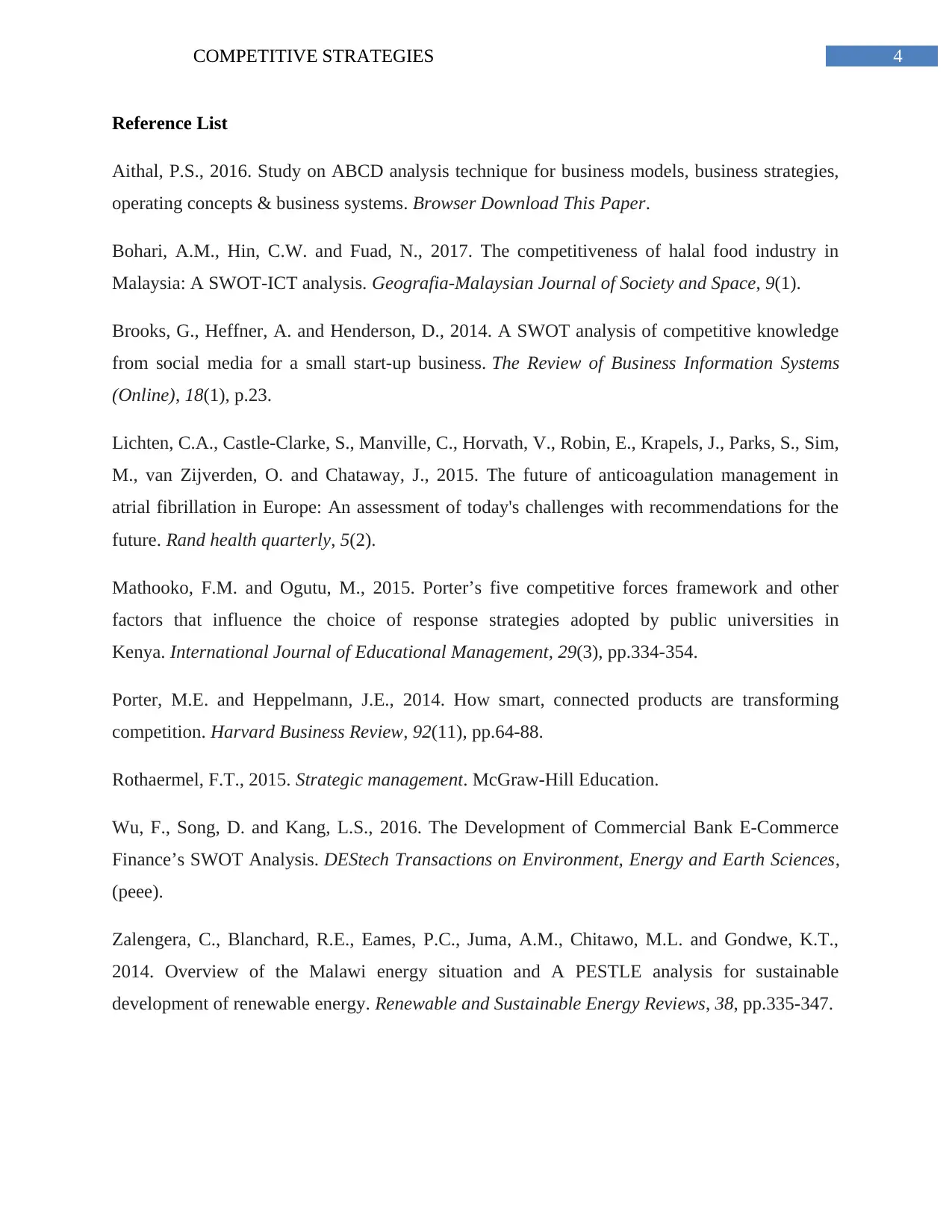
4COMPETITIVE STRATEGIES
Reference List
Aithal, P.S., 2016. Study on ABCD analysis technique for business models, business strategies,
operating concepts & business systems. Browser Download This Paper.
Bohari, A.M., Hin, C.W. and Fuad, N., 2017. The competitiveness of halal food industry in
Malaysia: A SWOT-ICT analysis. Geografia-Malaysian Journal of Society and Space, 9(1).
Brooks, G., Heffner, A. and Henderson, D., 2014. A SWOT analysis of competitive knowledge
from social media for a small start-up business. The Review of Business Information Systems
(Online), 18(1), p.23.
Lichten, C.A., Castle-Clarke, S., Manville, C., Horvath, V., Robin, E., Krapels, J., Parks, S., Sim,
M., van Zijverden, O. and Chataway, J., 2015. The future of anticoagulation management in
atrial fibrillation in Europe: An assessment of today's challenges with recommendations for the
future. Rand health quarterly, 5(2).
Mathooko, F.M. and Ogutu, M., 2015. Porter’s five competitive forces framework and other
factors that influence the choice of response strategies adopted by public universities in
Kenya. International Journal of Educational Management, 29(3), pp.334-354.
Porter, M.E. and Heppelmann, J.E., 2014. How smart, connected products are transforming
competition. Harvard Business Review, 92(11), pp.64-88.
Rothaermel, F.T., 2015. Strategic management. McGraw-Hill Education.
Wu, F., Song, D. and Kang, L.S., 2016. The Development of Commercial Bank E-Commerce
Finance’s SWOT Analysis. DEStech Transactions on Environment, Energy and Earth Sciences,
(peee).
Zalengera, C., Blanchard, R.E., Eames, P.C., Juma, A.M., Chitawo, M.L. and Gondwe, K.T.,
2014. Overview of the Malawi energy situation and A PESTLE analysis for sustainable
development of renewable energy. Renewable and Sustainable Energy Reviews, 38, pp.335-347.
Reference List
Aithal, P.S., 2016. Study on ABCD analysis technique for business models, business strategies,
operating concepts & business systems. Browser Download This Paper.
Bohari, A.M., Hin, C.W. and Fuad, N., 2017. The competitiveness of halal food industry in
Malaysia: A SWOT-ICT analysis. Geografia-Malaysian Journal of Society and Space, 9(1).
Brooks, G., Heffner, A. and Henderson, D., 2014. A SWOT analysis of competitive knowledge
from social media for a small start-up business. The Review of Business Information Systems
(Online), 18(1), p.23.
Lichten, C.A., Castle-Clarke, S., Manville, C., Horvath, V., Robin, E., Krapels, J., Parks, S., Sim,
M., van Zijverden, O. and Chataway, J., 2015. The future of anticoagulation management in
atrial fibrillation in Europe: An assessment of today's challenges with recommendations for the
future. Rand health quarterly, 5(2).
Mathooko, F.M. and Ogutu, M., 2015. Porter’s five competitive forces framework and other
factors that influence the choice of response strategies adopted by public universities in
Kenya. International Journal of Educational Management, 29(3), pp.334-354.
Porter, M.E. and Heppelmann, J.E., 2014. How smart, connected products are transforming
competition. Harvard Business Review, 92(11), pp.64-88.
Rothaermel, F.T., 2015. Strategic management. McGraw-Hill Education.
Wu, F., Song, D. and Kang, L.S., 2016. The Development of Commercial Bank E-Commerce
Finance’s SWOT Analysis. DEStech Transactions on Environment, Energy and Earth Sciences,
(peee).
Zalengera, C., Blanchard, R.E., Eames, P.C., Juma, A.M., Chitawo, M.L. and Gondwe, K.T.,
2014. Overview of the Malawi energy situation and A PESTLE analysis for sustainable
development of renewable energy. Renewable and Sustainable Energy Reviews, 38, pp.335-347.
1 out of 5
Related Documents
Your All-in-One AI-Powered Toolkit for Academic Success.
+13062052269
info@desklib.com
Available 24*7 on WhatsApp / Email
![[object Object]](/_next/static/media/star-bottom.7253800d.svg)
Unlock your academic potential
Copyright © 2020–2025 A2Z Services. All Rights Reserved. Developed and managed by ZUCOL.




